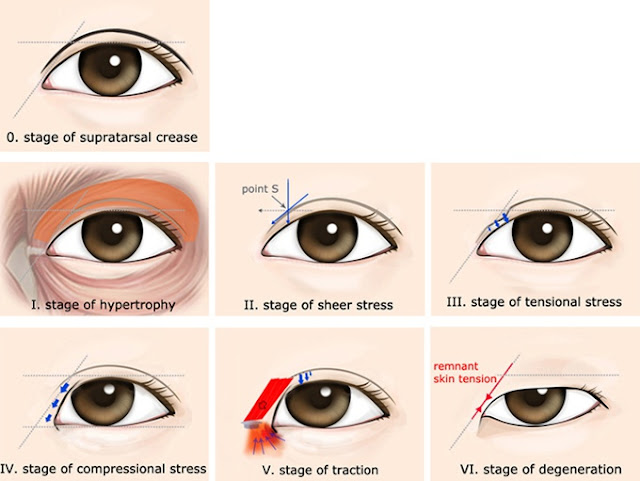What is epicanthoplasty (correction of epicanthal folds)?
Epicanthoplasty is the name of the surgery that corrects epicanthal folds that cover the inner corners of Asian eyes, making your eyes look more open, refined and bigger.
Epicanthoplasty can be helpful for people who have small eyes, wide apart eyes or severe looking eyes due to the inclination of the inner corners of their eyes by epicanthal folds.
When epicanthoplasty is performed with a double eyelid surgery, the horizontal length of eyes can be extended and the interepicanthal distance will also be narrowed effectively. Also, attractive and refined double eyelids will be created by improvement of the epicanthal folds. Double eyelidplasty is the most popular cosmetic procedure for Asians, and the epicanthus was a conundrum which limit cosmetic result of double eyelidplasty.
Double eyelidplasty without epicanthoplasty tend to be unattractive or unnatural. Aesthetically, the epicanthal fold is worsened when performing double eyelidplasty without epicanthoplasty because double eyelid formation aggravates vertical tension on epicanthal skin. It has been a long-standing dilemma for plastic surgeons to decide on a procedure, i.e. infold type double eyelidplasty with a less satisfactory result or outfold type double eyelidplasty with concomitant epicanthoplasty, taking risk of hypertrophic scar in Asian eyelid. When the epicanthal fold is severe, the surgical incision of skin flap also become longer, and a scar could be easily visible in conventional method, which based on the concept of local skin flap and lacked a consideration of upper orbicularis muscle and vertical epicanthal tension.
Although it has been reasoned that combined epicanthoplasty is helpful in Asian double eyelidplasty, there has not been clear understanding about epicanthal fold, resulting in controversies for solution. There have been so many epicanthoplasty methods developed in its early days, which are mostly based on skin flap concept. Currently using methods are combined technics including skin excision, z-plasty, myotomy or myectomy of preseptal orbicularis muscle, skin redraping, plication of medial canthal ligament and so on. The development of incomplete methods were unavoidable without understanding about true nature of the epicanthus. As the clinical significance of the epicanthus is mainly related with Asian double eyelidplasty, essential epicanthoplasty should be a key to plastic surgeons for choice of all the type of double eyelid including high outfold type(parallel type). But, there has not yet been a potent epicanthoplasty method which deserves universal solution for Asian double eyelidplasty. So we developed Kwon's method based on devolutional concept.
What is Kwon's method (Devolution epicanthoplasty=Magic epicanthoplasty)?
Magic epicanthoplasty(Kwon’s method) is a unique method for correcting epicanthal folds of Asian eyelid, and is the surgery to be first founded by Dr. Kwon. Kwon’s method is based on the devolutional concept that restores original pericanthal structure for stable double eyelid formation without anatomical distortion. It can be accomplished by just rearranging the soft tissue without risk of severe complication or noticeable scar. Unlike conventional methods, Magic epicanthoplasty primarily releases the malpositioned soft tissues and fibrosis, then leads to the restoration of the medial canthus naturally without the removal of the skin or muscle.
Magic epicanthoplasty(Kwon’s method) is a universal method for various Asian epicanthus, and is the basal surgery for double eyelidplasty for Asian.
The clinical significance of epicanthal fold is mainly related with double eyelidplasty in Asians.
Epicanthal fold is worsened when performing double eyelidplasty without epicanthoplastyas double eyelid aggravates tension on epicanthal skin. And aesthetic results of double eyelidplasty without epicanthoplasty tend to be unnatural or unattractive.When performing out-fold type eyelidplasty without epicanthoplasty, prolonged swelling retention(so-called sausage phenomenon) occurs due to blockage of lymphatic flow by vertical tension and fading away of double eyelids are frequently noted.Unless the epicanthoplasty releases skin tension and remove potential inhibition factors of crease loss, the surgical crease will not look natural or not be able to last in any enduring fashion.
In the early days of epicanthoplasty surgery, numerous surgical methods were introduced to correct the redundant skin fold which were based on the concept of local flaps.
However, their disadvantages such as difficulty in design and resultant prominent scars had limited their use. Recently new epicanthoplasty methods have been introduced to correct Asian anatomical differences such as excessive skin, abnormal skin tension, a malpositioned orbicularis muscle, fibroadipose tissue, elongated medial canthal ligament, etc. However, none of them could be a treatment of choice as they lacked exact understanding regarding the malposition of upper orbicularis muscle and vertical skin tension in relation to the double eyelid. The surgical methods based on defective/inadequate understanding of the true nature of the epicanthus could not be sufficiently effectivefor Asian eyelidplasty.
Epicanthoplasty using devolutional method(Kwon's method) was developed on the basis of our understanding of epicanthal formation and causal relationship with double eyelid. Therefore, it is a completely new technique first made by Dr. Bongsik Kwon. This method is also called the magic epicanthoplasty. With good reports and reputations by people who have already undertaken this, it is becoming a term that is commonly used in Korea and in many other countries.
To perform magic epicanthoplasty, a surgeon needs plentiful experiences and extreme carefulness to acomplish optimal results. Teuim plastic surgical clinic have more than 5000 cases of magic epicanthoplasty alone or combined double eyelid surgeries.
Example) Magic epicanthoplasty in Asian single eyelid
Example)Magic epicanthoplasty in Asian with double eyelid
Example)Combination of the Magic epicanthoplasty with the non-incisional double
eyelid surgery
Example)Combination of the Magic epicanthoplasty with the incisional double
eyelid surgery
Example)Combination of the Magic epicanthoplasty with the ptosis correction
surgery
Example)Combination of the Magic epicanthoplasty with revisional
double eyelid surgery
-Teuim Clinic Dr.Kwon-
E-mail: paris85@naver.com


















